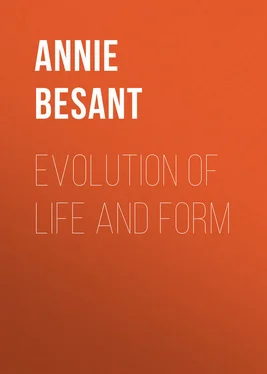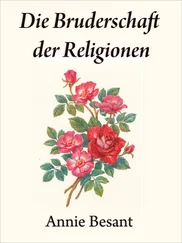Annie Besant - Evolution of Life and Form
Здесь есть возможность читать онлайн «Annie Besant - Evolution of Life and Form» — ознакомительный отрывок электронной книги совершенно бесплатно, а после прочтения отрывка купить полную версию. В некоторых случаях можно слушать аудио, скачать через торрент в формате fb2 и присутствует краткое содержание. Жанр: foreign_antique, foreign_prose, на английском языке. Описание произведения, (предисловие) а так же отзывы посетителей доступны на портале библиотеки ЛибКат.
- Название:Evolution of Life and Form
- Автор:
- Жанр:
- Год:неизвестен
- ISBN:нет данных
- Рейтинг книги:4 / 5. Голосов: 1
-
Избранное:Добавить в избранное
- Отзывы:
-
Ваша оценка:
- 80
- 1
- 2
- 3
- 4
- 5
Evolution of Life and Form: краткое содержание, описание и аннотация
Предлагаем к чтению аннотацию, описание, краткое содержание или предисловие (зависит от того, что написал сам автор книги «Evolution of Life and Form»). Если вы не нашли необходимую информацию о книге — напишите в комментариях, мы постараемся отыскать её.
Evolution of Life and Form — читать онлайн ознакомительный отрывок
Ниже представлен текст книги, разбитый по страницам. Система сохранения места последней прочитанной страницы, позволяет с удобством читать онлайн бесплатно книгу «Evolution of Life and Form», без необходимости каждый раз заново искать на чём Вы остановились. Поставьте закладку, и сможете в любой момент перейти на страницу, на которой закончили чтение.
Интервал:
Закладка:
The scientific man of antiquity, then, began by that self-attention, unfolding in himself one by one all those potentialities under a suitable Guru, passing from step to step till he reached the highest, and ever worshipping the Mahâguru, the Guru of the universe. Having unfolded his highest powers, he began to study life, life in its outpouring, not life in its manifold and veiled manifestations in the lower worlds. Hence the lofty point at which he started, no less than the arising of Íshvara enveloped in Mâyâ.
What is Íshvara? What is Mâyâ? There is the first great problem. Let us reverently address ourselves to it. The philosophers of India have answered these questions in different ways, each one containing part of the eternal truth. Íshvara is that mighty centre of consciousness that exists unchanged in the bosom of the One Existence. There are innumerable such Centres of Consciousness, of which you may remember your own Svâmi Subba Rao wrote as existing in the bosom of the One Existence. Íshvara in manifestation is like a lamp, a light enclosed in a shade. Íshvara, enveloped in Mâyâ, brings forth a universe and is enclosed, as it were, in the universe of which He is the Light. Breaking the shade, the light shines forth in every direction. Dissolving the universe, He still remains. The centre remains, but the circumference that circumscribed it is gone. So is that mighty centre when the universe vanishes; He alone remains, holding His centre unshaken in the very act of merging in, expanding into, the Infinite, the Absolute, the Super-Consciousness, the One. Let us think of Him as an eternal centre of self-consciousness, able to merge in super-consciousness and to again limit Himself to self-consciousness.
What, then, is Mâyâ? Mâyâ is prepared in every case by the merging in Íshvara of the whole of the universe which is come to its ending. As one loka rolls up and merges in the one above it, all forms in the loka thus merged disappear, but the consciousness that ensouled those forms does not vanish; a modification of consciousness remains, a modification expressing itself by a vibratory power – not a vibration, but a power to vibrate in a particular way; and though the form vanishes as the loka is merged in the one above it – because the matter disappears, being disintegrated into finer matter – in consciousness there remains the power to vibrate in the way in which it had vibrated in the grosser matter, and power persists although the forms caused by such vibrations disappear, for lack of material sufficiently coarse to respond to such vibrations. As one region passes into the next, this process is repeated over and over and over again, and loka after loka vanishes. The forms are gone, the vibrations are gone, only the modifications in consciousness capable of giving rise to similar vibrations remain until finally, when Íshvara – whose consciousness was the one consciousness in the universe, whose life was the one life, who supported every form, who made the possibility of every separated existence – gathers up His universe into Himself ere He merges Himself in the One, everything has vanished that we know as form, nothing remains save the centre of consciousness. There remains in Íshvara the power of vibrating in particular fashions, resulting from the evolution of His universe, in endless multiplicity of vibrations; when He merges Himself in the One Existence all has vanished as form, but powers remain in these subtle modifications, preserved in that unchangeable centre in the mightiness of the One Life. Is that only a dream?
There was a great teacher, Vâsiṣhtha. He taught Râmâ, as you will remember, and in the record of his teaching there are hints on some of the mysteries of life. If you keep what I have now said in mind, if I have succeeded by the clumsy words which are all that the human tongue can utter on these great problems, in clarifying at all your thoughts, then just listen to that same thought as expressed by Sûryadeva, when he was speaking of the same thing – the ending and the new beginning of a universe. We have only to add to what I have already said, that when Íshvara arises in order that a new universe may be formed, He throws His life into these modifications that had apparently disappeared, and the Mâyâ in which He arises, enveloped and circumscribed, is His own re-vivified memory, which can never be separated from Himself; He draws in His consciousness, under the impulse of the Great Breath, limiting it to self-consciousness, and turning His attention to the contents of that self-consciousness, its powers start into activity, and that is Mâyâ. So it is written: "Thereafter, Thou, O Lord, intent on [maintaining] the reign of night, fixed within the Self, having indrawn that order of things, [or universe.]… To-day, Thou hast awakened, and art most joyfully desirous of again throwing out [manifesting] the universe in mighty gradations [hierarchies of beings]." [ Yoga Vâsiṣhtha , lxxxvii, 7, 8.] These nights and days are the "Nights and Days of Brahmâ," the inbreathing and outbreathing of the One Existence, and Mâyâ is this indrawn "order of things" that remains fixed through the Night, and starts forth as Íshvara awakens at the coming of Day. That is Mâyâ and if you take up the definitions given in the different schools, you will find that this includes and illumines every one of them, that it shows you what is meant by illusion, and explains to you what is implied in dreaming. The joyful throwing out into manifestation of all the powers that are remembered by Íshvara the moment His attention is turned to His own Self, that memory-prompted "desire" which arises in the bosom of the Eternal, is the root of the coming universe. Now this thought will prove to you the key of much ancient teaching. You have, in the Universal Mind full of ideas which are not yet concreted into phenomena, the world of ideas of Plato, the invisible world of the Hebrew Kabbalah; in every great teaching you find the same thought expressed. If, instead of being fettered by words, as for the most part we are, and if, instead of repeating phrases that carry with them no idea in the mind of the repeater, we would try to read the thought that underlies the words, we should find the Hindu philosophy in every modern philosophy that is worthy of the name, and see the traces of ancient India in Greece and in Rome, in Germany and in the England of to-day.
What is the next stage? The Life-Breath goes forth. Íshvara, the Centre of all, enveloped in Mâyâ sends forth His breath; as that vibrating breath falls on the enveloping Mâyâ, Mâyâ becomes Prakriti, or Matter – rather, perhaps, Mûlaprakriti, the root of matter. As that breath, with its triple vibratory force falls on this matter, it throws it into three modifications, or "attributes" – Tamas, inertia, or better, stability; Rajas, activity, vigour; Sattva, a difficult word to translate: I am inclined to translate it as Harmony; for this reason, that wherever there is pleasure, Sattva is present. Without harmony no pleasure can anywhere exist. All pleasure is due to harmonious vibration, and that quality of harmonious inter-related vibrations is the quality that Sattva gives to matter. These three fundamental qualities of matter – answering to three fundamental modifications in the consciousness of Íshvara – inertia, activity, and harmony, these are the famous three Gunas without which Prakriti cannot manifest. Fundamental, essential, and unchangeable, they are present in every particle in the manifested universe, and according to their combinations is the nature of each particle.
Then comes the seven-fold division. In a moment I will tell you why we speak of it as seven-fold instead of five-fold, which is the more familiar division to you. The seven-fold division, what is this? Here is matter with its three Gunas, now ready to receive another impulse from the Life-Breath; that breath comes forth from Brahmâ, for Íshvara has unfolded His triple nature into its three aspects, and it comes forth in seven great waves. Each one modifies matter, and evolves and ensouls those that follow it. The first two are absolutely beyond our knowing, and belong not to our present stages of evolution at all; therefore they are ordinarily left out, and only the five that make up the evolution of our universe are spoken of in the sacred books. Here and there the seven are mentioned, but only rarely. You may remember the seven tongues of fire, for instance, and one or two other similar phrases. But generally five-fold is Prâna, the five-fold evolving life. First, in every case, is a modification of consciousness sent forth as a power by Íshvara. Turn to the Vishnu Purâna and you will see exactly the stage that I am pointing out to you in more modern phrases. Íshvara Himself, as Brahmâ, sends forth a power, due to a modification of His consciousness, called in the Vishnu Purâna a Tanmâtra. In the English translation the word rudiment is used. You remember the rudiments of sound, of touch, of colour, and so on. All these rudiments are the tanmâtras. These tanmâtras are the powers due to modifications in consciousness or life, without which no modification in matter can be. The consciousness first, then the form. The first great vibration that goes forth is the vibration that gives rise to what we speak of here as sound – all our terms being drawn from the lowest, or physical, manifestations; the form that it brings into manifestation is A'kâsha, the mighty element of Ether; not the ether of modern science, of course, although that is its physical representative. Then into that the next tanmâtra, the next power due to a modification of consciousness, is sent forth; the A'kâsha, with the primary vibration within it, receives the second vibration sent out by Íshvara, and this, pervading the matter around it, brings about the next modification of matter, the element Vâyu, or Air. Vâyu, permeated, ensouled and enveloped in A'kâsha, receives a fresh impulse from Íshvara, the third tanmâtra, or power resulting from a modification of consciousness; this tanmâtra, working on Vâyu, produces the modification of matter called the element Agni, or Fire, and this fire-matter is permeated, ensouled, and enveloped in Vâyu, as Vâyu in A'kâsha. A similar process brings into manifestation the elements Apas and Prithivî. The "magnetic field" of an atom is composed of all the tanmâtras and elements above it. Try to realise this process if you can, though I know the conception is difficult. What has occurred? A modification of life or consciousness in Íshvara, manifested as a power, a vibration; everything depends on vibration; ancient and modern science speak alike on this. The universe is made up of vibrations, the vibrations which are the modifications of the Divine outpouring of life. These clothe themselves in fundamental forms of matter, out of which all multiplicity is developed. These modifications in matter, these great, or primary, elements are also called tattvas. Tanmâtras, then, are the powers sent out by modifications of consciousness, and these are awkwardly translated by the word rudiments; we have next the modifications in matter, the great elements, the primary elements, or tattvas. The first of the tattvas is called A'kâsha; then Vâyu, then Agni, then Apas, then Prithivî, the five following one after the other; the keynote of this evolution is that the modification of the previous higher tattva is reproduced within the lower, pervades it and expands outside it. If you will take the Vishnu Purâna , the second chapter, and read over again the evolution of the five tattvas, you will find that the Sanskrit word which is used comes from a root which means to pervade as well as to enclose, giving the idea of permeation as well as of expanding around to form an envelope. And you must understand that the central life of each tattva is the preceding tattva with its tanmâtra; that, with the new tanmâtra, makes up the life; and the outer form is the new tattva that by that productive action comes into existence.
Читать дальшеИнтервал:
Закладка:
Похожие книги на «Evolution of Life and Form»
Представляем Вашему вниманию похожие книги на «Evolution of Life and Form» списком для выбора. Мы отобрали схожую по названию и смыслу литературу в надежде предоставить читателям больше вариантов отыскать новые, интересные, ещё непрочитанные произведения.
Обсуждение, отзывы о книге «Evolution of Life and Form» и просто собственные мнения читателей. Оставьте ваши комментарии, напишите, что Вы думаете о произведении, его смысле или главных героях. Укажите что конкретно понравилось, а что нет, и почему Вы так считаете.











